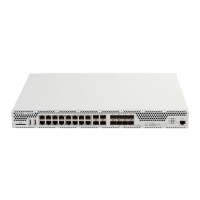60 ESR Series Routers Operation Manual
For R1 router, proceed to 1.1.1.1 area configuration mode:
esr(config-ospf)# area 1.1.1.1
Create and enable virtual link with the identifier 0.0.0.3:
esr(config-ospf-area)# virtual-link 0.0.0.3
esr(config-ospf-vlink)# enable
For R3 router, proceed to 1.1.1.1 area configuration mode:
esr(config-ospf)# area 1.1.1.1
Create and enable virtual link with the identifier 0.0.0.1:
esr(config-ospf-area)# virtual-link 0.0.0.1
esr(config-ospf-vlink)# enable
Configuration changes will take effect when the configuration is applied:
esr# commit
Configuration has been successfully committed
esr# confirm
Configuration has been successfully confirmed
Review the routing table on R1 router:
esr# show ip route
C * 10.0.0.0/24 [0/0] dev gi1/0/12, [direct 00:49:34]
O * 10.0.1.0/24 [150/20] via 10.0.0.1 on gi1/0/12, [ospf1 00:49:53] (0.0.0.3)
O * 192.168.20.0/24 [150/30] via 10.0.0.1 on gi1/0/12, [ospf1 00:50:15] (0.0.0.3)
C * 192.168.10.0/24 [0/0] dev lo1, [direct 21:32:01]
Review the routing table on R3 router:
esr# show ip route
O * 10.0.0.0/24 [150/20] via 10.0.1.1 on gi1/0/12, [ospf1 14:38:35] (0.0.0.2)
C * 10.0.1.0/24 [0/0] dev gi1/0/12, [direct 14:35:34]
C * 192.168.20.0/24 [0/0] dev lo1, [direct 14:32:58]
O * 192.168.10.0/24 [150/30] via 10.0.1.1 on gi1/0/12, [ospf1 14:39:54] (0.0.0.1)
Since OSPF considers virtual link as the part of the area, R1 routes received from R3 are marked as
an intrazone and vice versa.
To view the neighbours, use the following command:
esr# show ip ospf neighbors 10
To view OSPF routing table, use the following command:
esr# show ip ospf 10

